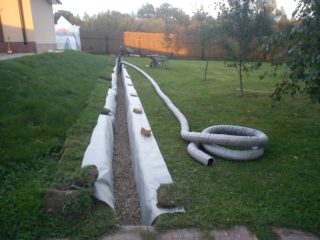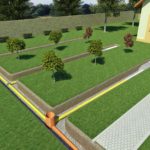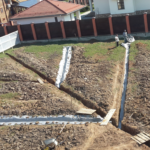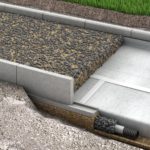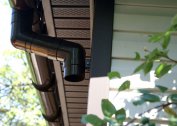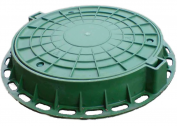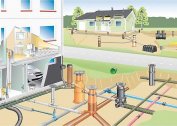The task of the drainage system is to collect excess water in a certain area and drain from the site. Modern drainage products are efficient, reliable and easy to install. One of the types of pipes used for the construction of drainage systems is corrugated drainage products with perforation.
Scope of a corrugated drainage pipe with geotextile
To drain from the site of storm and melt water use shallow drainage systems. If you want to lower the groundwater level, use deep structures.
Perforated corrugated drainage pipe with geotextile is used to:
- protection of foundations, basements and the basement of buildings and structures from flooding;
- gentrification sites;
- device drainage systems in agriculture and forestry;
- drainage in the construction of roads.
The device drainage systems provide for the construction of any buildings and structures.
Advantages and disadvantages of corrugated drain pipe
The perforated corrugated element has holes located between the folds. This design helps to cope effectively with the problem of removing excess water from the soil surface. Equipping the pipe with geotextiles prevents particles of soil and debris from entering.
The use of corrugated drainage products with perforation gives many advantages:
- The corrugated outer shell has strength and ring stiffness.
- Geofabric protects the drainage system from clogging with soil, serves as a filter for wastewater treatment.
- Depending on the stiffness class, pipes can be laid at various depths.
- Corrugated pipes have good flexibility indicators - during storage and transportation they are folded into bays.
- The materials from which the products are made are not susceptible to corrosion and decay.
- Corrugated pipes are lightweight.
- Installation of corrugated plastic elements is quite simple.
- A large number of connecting parts is not required, as corrugated products are quite flexible.
- The service life of most products is at least 50 years.
- Low cost of pipes and fittings.
- Are applied on sites of any area.
A relative disadvantage of corrugated plastic pipes is the loss of strength at high temperatures.
The use of geofabric as a filter also has its advantages:
- not damaged by insects and rodents;
- does not give in to decay;
- resistant to various chemicals;
- elasticity allows to withstand large mechanical loads;
- service life is at least 25 years.
The use of geo-fabrics protects the reclamation system from pollution inside the structure.
Types of pipes
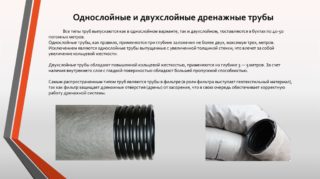 Drainage pipes are produced in a smooth or corrugated form. The price of corrugated products is higher, but they are more convenient for installation.
Drainage pipes are produced in a smooth or corrugated form. The price of corrugated products is higher, but they are more convenient for installation.
Corrugated products are manufactured in a single-layer or multi-layer version. Single wall perforated pipe is optimal for laying at shallow depths. Two-layer structures combine the high strength of the outer shell with an absolutely smooth inner layer.
Corrugated drainage parts are made of the following materials:
- HDPE (low pressure polyethylene) - the most common in individual construction.Corrugated drainage pipes made of polyethylene are excellent for laying to a depth of 4 meters. They have good technical characteristics: strength, chemical resistance, flexibility.
- PVC (polyvinyl chloride) - are made by standard lengths, used to arrange systems at a depth of 4 -10 meters. They have greater rigidity than polyethylene. But it’s more fragile.
- PP (polypropylene).
Double-walled products are combined from various plastics. In addition, parts produce various stiffnesses.
- For deepening up to 1 meter, single-layer products with a hardness grade of SN2 are used.
- Pipes of stiffness class SN4 are laid in trenches up to 2 meters deep.
- When constructing the structure to a depth of 4 meters, it is worth using two-layer elements of stiffness SN6.
Such options are sold both in bays and in sections. When laying a drainage system below 4 meters, segments of stiffness SN6, SN8 and higher are used.
Filters for drainage pipes are made of coconut fiber or geotextiles. The price of natural material is higher. The geotextile filter will last a long time if gravel is sprinkled around the drainage system.
Due to the presence of a smooth inner layer, two-layer structures are often used without an additional filter. They are less prone to siltation and blockages.
Partial or full perforation products are also distinguished. The holes in the pipe are made only from above, or along the entire diameter. They are made round or in the form of cracks.
Product Dimensions
 The most common are pipes with a diameter of 63 mm, 110 mm, 160 mm, 200 mm. They are produced in segments of 3 m, 6 m, 12 m. But they are more convenient to use in bays. They are easier to mount, the design has fewer connecting elements. 40 m, 50 m or 100 m pipes are wound into bays, depending on the diameter.
The most common are pipes with a diameter of 63 mm, 110 mm, 160 mm, 200 mm. They are produced in segments of 3 m, 6 m, 12 m. But they are more convenient to use in bays. They are easier to mount, the design has fewer connecting elements. 40 m, 50 m or 100 m pipes are wound into bays, depending on the diameter.
The size of the drainage pipes is selected depending on the amount of water that needs to be collected and taken away.
- For a drainage device in a small area, pipes with a diameter of 110 mm are often used.
- If the perimeter of the territory is large enough, use products with a size of 160 mm.
- The large volume of collected water, the individual characteristics of the drainage site may require the use of models of a much larger diameter.
Small-format products, for example, corrugated drainage pipes 63 mm or 50 mm, are often used for forced soil moistening. This may be the removal of moisture from the stormwater system or treated sewage.
Installation and installation rules
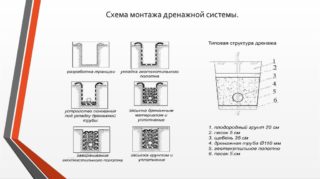 When installing a drainage system from corrugated pipes for water drainage, it is worth adhering to a certain technology. The main stages of work:
When installing a drainage system from corrugated pipes for water drainage, it is worth adhering to a certain technology. The main stages of work:
- A well is installed to receive the removed moisture in the lowest place of the drained site. Often you can do without this element, if it is possible to drain the water into a normal sewer, ravine or stream. Moisture is removed from the well by gravity or using a pump.
- They dig trenches for the construction manually or using special equipment. The width of the ditch is calculated as the sum of the diameter of the pipe plus 20-30 cm.
- The system is given a certain bias towards the drainage well. It is 1-2 cm per mp
- The corrugated drainage structure is laid on a sand base at least 5 cm thick. It needs to be leveled and tamped.
- A geotextile is laid on the sand layer.
- Next, a layer of crushed stone is poured. Fractions from 20 mm to 40 mm are selected.
- Lay and connect all parts of the system.
- From above, crushed stone is again covered with a layer of 10-15 cm.
- The overlapping geotextile material covers the entire structure.
- Sand or fine gravel is poured on top.
- Backfill the soil.
Each layer is rammed, sand is shed with water.
Between themselves, the individual elements are connected using couplings, bends, tees. Fittings designed for ordinary sewage are suitable for products with a diameter of 110 mm, 160 mm and 200 mm.But it is better to use special fittings for corrugated drainage. They have latches for quick installation.
A method of connecting parts without the use of couplings is also used. In this case, the end of one part is incised and put on another element. At the junction, it is necessary to additionally impose a geo-fabric and fix it. Special tightness of joints in drainage systems is not required.
The angle of inclination of the structure is selected depending on the level of groundwater, the type of soil on the site and the features of the relief.
Ways of laying drainage elements:
- Parallel to each other with water drainage to the central pipe.
- "Herringbone" - the main outlet element is located in the center.
- Along garden paths, slopes, retaining structures towards the catchment well.
It is worth considering some points:
- A deep drainage system is laid below the foundation of the building.
- The design is arranged around the perimeter of the structure or in several directions on the site.
- The drainage system starts at the highest point of the drainage site.
- It is desirable to connect all elements to the central pipe at an angle of 45 degrees.
- Between the lines should provide a distance of 6-10 meters.
- To monitor the condition of the system in places of complex connections, inspection wells are performed. The distance between them should be approximately 50 meters.
After putting the drainage system into operation, its periodic check is required. At least once a year, it is worth inspecting the structure through the control wells. The water level in the catchment is also checked.
The inefficient operation of the drainage system has several reasons:
- clogging of elements with silt;
- clogging of drainage holes;
- mechanical damage to elements;
- subsidence of the structure under the weight of the soil.
Compliance with the technology of the device drainage system will allow to operate it for a long time and trouble-free.
Corrugated Pipe Drain Prices
The cost of drainage products depends on the materials, sizes and manufacturer. The price of corrugated drainage single-layer PVC pipes without filter is the lowest. Double-walled models with geotextile will cost much more.
Corrugated drainage pipes with geo-fabric - the best option for use in private construction, or in the construction of public or industrial buildings and structures. Due to their excellent technical characteristics, such systems are used for a long time and reliably.
